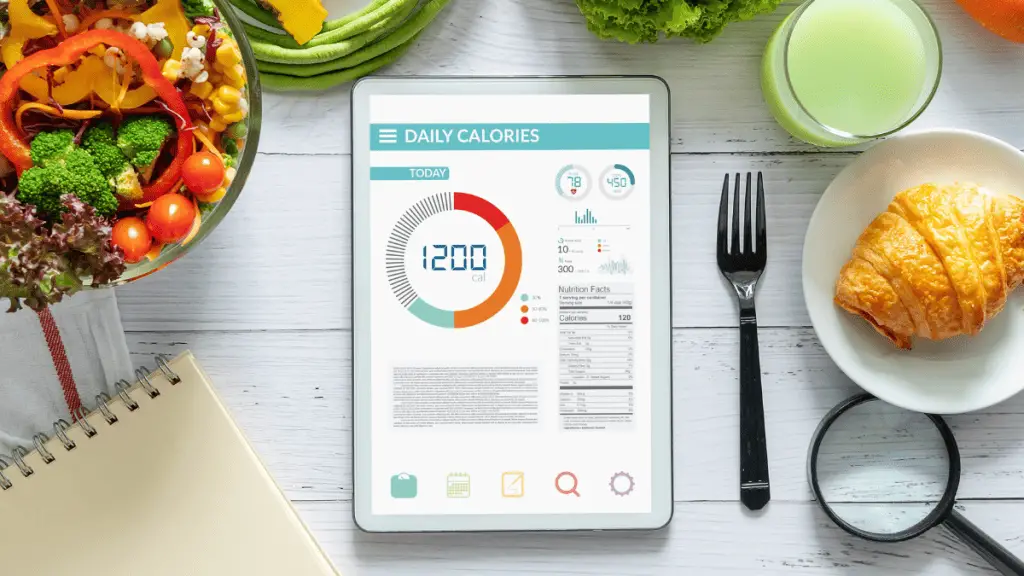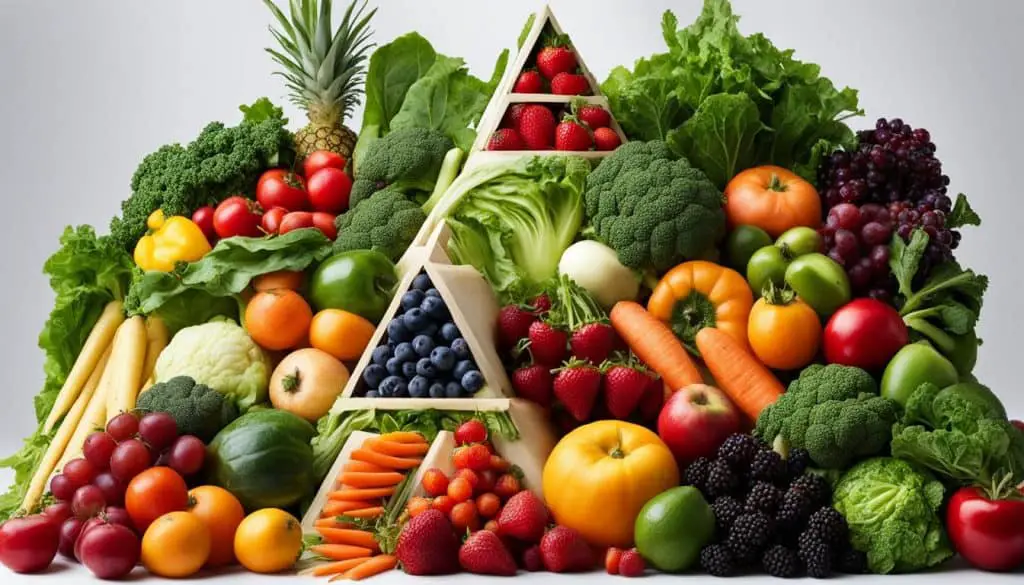
Welcome to my beginner’s guide on how to lose 3 pounds a week! If you’re looking to kick-start your weight loss journey, you’ve come to the right place. Losing weight gradually and sustainably is key, especially for beginners. In this guide, I’ll provide you with strategies and tips to help you achieve your weight loss goals while prioritizing your health and well-being.
Before diving into the specifics, it’s important to understand the basics. First, it’s crucial to calculate your basal metabolic rate (BMR), which determines how many calories you burn in a day. This information will help you create a calorie deficit and guide your weight loss efforts.
Key Takeaways:
- Calculate your BMR to determine your daily calorie needs.
- Create a daily calorie deficit of 1,500 calories to lose 3 pounds a week.
- Eat at least 1,200 calories per day (women) or 1,500 calories per day (men) to ensure a healthy intake.
- Track your food intake using a tracking app or food diary.
- Incorporate fruits, vegetables, lean proteins, and whole grains into your diet.
Setting a Calorie Goal for Weight Loss

To achieve significant weight loss, it is crucial to set a calorie goal that creates a daily calorie deficit. By carefully managing your calorie intake and expenditure, you can pave the way for sustainable weight loss. Here’s how to establish an effective calorie goal:
- Calculate your baseline calorie intake:
Determining your Basal Metabolic Rate (BMR) serves as the foundation for setting your calorie goal. The BMR represents the number of calories your body needs to maintain its current weight at rest. To find out your BMR, you can use an online calculator or the revised Harris-Benedict equation. Once you have calculated your BMR, subtract 1,500 calories from it.
- Ensure a healthy calorie intake:
While it’s essential to create a calorie deficit, it’s equally important to avoid excessively low calorie intake. Women should consume a minimum of 1,200 calories per day, while men should aim for at least 1,500 calories per day. Restricting calories beyond these thresholds can lead to nutrient deficiencies and other health problems.
- Adjust your calorie goal:
Your individual needs and metabolism play a significant role in weight loss. Adjust your calorie goal based on your BMR, activity level, and any specific dietary requirements. Consulting with a healthcare professional or registered dietitian can provide valuable guidance to ensure safe and sustainable weight loss.
- Tracking your calorie intake:
To stay on track with your calorie goal, make use of tracking apps or food diaries. These tools allow you to monitor your daily calorie intake and evaluate your progress towards your weight loss goals.
- Enhance your calorie deficit through exercise:
Incorporating physical activity is an excellent way to increase calorie expenditure. Aim to burn an additional 400 calories per day through exercise, such as cardiovascular workouts, strength training, or high-intensity interval training (HIIT). Remember to choose exercises that you enjoy and that align with your fitness level.
Recommended Calorie Intake for Weight Loss
| Gender | Minimum Daily Calorie Intake for Weight Loss |
|---|---|
| Women | At least 1,200 calories per day |
| Men | At least 1,500 calories per day |
Choosing Nutritious Foods for Weight Loss

When it comes to losing weight, choosing the right foods is key. By focusing on nutrient-dense and calorie-lean options, you can achieve your weight loss goals while nourishing your body.
Here are some nutritious foods that can help accelerate your weight loss journey:
1. Fruits and Vegetables
Include a variety of fruits and vegetables in your diet. They are low in calories and high in essential vitamins, minerals, and antioxidants that support overall health. Leafy greens, such as spinach and kale, are particularly beneficial for weight loss as they are packed with nutrients and fiber, keeping you feeling full for longer.
2. Lean Proteins
Choose lean sources of protein, such as skinless chicken breast, turkey, fish, tofu, and legumes. Protein is essential for maintaining muscle mass while promoting satiety. It also requires more energy to digest, helping you burn more calories throughout the day.
3. Whole Grains
Opt for whole grains like quinoa, brown rice, and oatmeal instead of refined carbohydrates. Whole grains are rich in fiber, which aids in digestion and helps control hunger. They also provide sustained energy, keeping you satisfied and preventing cravings.
4. Healthy Fats
Incorporate sources of healthy fats into your diet, such as avocados, nuts, seeds, and olive oil. While fats are higher in calories, they provide essential nutrients and promote feelings of fullness. Including healthy fats can help curb cravings and prevent overeating.
5. Probiotic-Rich Foods
Add probiotic-rich foods like yogurt, kefir, sauerkraut, and kimchi to your meals. Probiotics promote a healthy gut microbiome, which aids in digestion and absorption of nutrients. They may also play a role in weight management and reducing inflammation in the body.
| Food Group | Examples |
|---|---|
| Fruits and Vegetables | Spinach, kale, berries, apples, broccoli |
| Lean Proteins | Skinless chicken breast, turkey, fish, tofu, legumes |
| Whole Grains | Quinoa, brown rice, oatmeal, whole-wheat bread |
| Healthy Fats | Avocados, nuts, seeds, olive oil |
| Probiotic-Rich Foods | Yogurt, kefir, sauerkraut, kimchi |
Avoid or limit highly processed foods that are high in calories, added sugars, and unhealthy fats. These foods can hinder your weight loss efforts and may lead to inflammation and other health issues.
By incorporating these nutritious foods into your diet, you can create a balanced and satisfying meal plan that supports weight loss while nourishing your body with essential nutrients.
Incorporating Exercise for Weight Loss

Exercise plays a crucial role in achieving weight loss goals. By combining cardiovascular exercise, high-intensity interval training (HIIT), and resistance training, you can maximize calorie burn, build muscle, and boost your metabolism. Here’s how you can incorporate these types of exercise into your routine:
- Cardiovascular Exercise: Aim to include at least 30 minutes of cardiovascular exercise, such as walking, jogging, cycling, or swimming, on most days of the week. This type of exercise helps increase your heart rate, burn calories, and improve overall fitness. To maintain overall health, aim for a total of 150 minutes of moderate cardiovascular activity per week. If you’re specifically looking to lose weight, you might need to increase either the duration or intensity of your cardio sessions.
- High-Intensity Interval Training (HIIT): Consider incorporating HIIT workouts into your exercise routine for maximum calorie burn. HIIT involves alternating between periods of moderate exercise and vigorous exercise. These short bursts of intense activity help elevate your heart rate and stimulate fat burning, even after your workout is over. Add HIIT sessions 1-2 times per week to challenge your body and boost weight loss results.
- Resistance Training: Including resistance or strength training exercises in your routine is crucial for weight loss. Building muscle increases your metabolism, allowing you to burn more calories throughout the day. Aim for two 30 to 45-minute strength training sessions per week, targeting all major muscle groups. Utilize exercises such as weightlifting, bodyweight exercises, or resistance bands to strengthen and tone your body.
To further enhance your weight loss efforts, try to increase your daily physical activity beyond structured exercise sessions. Look for opportunities to be active throughout the day, such as taking the stairs instead of the elevator, walking or biking for short errands, or parking further away from entrances. Every little bit adds up!
Remember, it’s essential to listen to your body and make gradual progress. If you’re new to exercise or have any health concerns, consult with a healthcare professional before starting any new fitness regimen. They can provide personalized guidance and ensure you’re exercising safely.
Safety and Realistic Expectations for Weight Loss
When it comes to losing weight, safety should always be a top priority. While the idea of losing 3 pounds a week may be enticing, it’s important to set realistic goals that prioritize your well-being. Rapid weight loss can lead to muscle loss, nutritional deficiencies, gallstones, and other health complications. To ensure a sustainable journey, it’s generally recommended to aim for a weight loss of 1-2 pounds per week.
Before embarking on any weight loss plan, it’s crucial to consult with a healthcare professional or a registered dietitian. They can provide guidance based on your individual health needs and help you create a safe and suitable weight loss plan. Remember, everyone’s journey is unique, and it’s essential to listen to your body and prioritize overall health rather than solely focusing on the number on the scale.

Building healthy habits should always be the goal when embarking on a weight loss journey. Instead of fixating on the outcome, shift your focus to behaviors such as balanced eating, regular physical activity, and overall well-being. By adopting a holistic approach and making sustainable choices, you can achieve long-lasting success in your weight loss journey.
The Role of Intuitive Eating in Long-Term Health
When it comes to achieving long-term health and well-being, adopting an intuitive eating approach can play a crucial role. Intuitive eating focuses on building a healthy relationship with food and embracing a weight-neutral care philosophy, prioritizing behaviors and habits that promote overall health.
Intuitive eating empowers individuals to listen to their body’s cues of hunger and fullness, trusting their body’s wisdom to guide their eating decisions. It involves honoring cravings and enjoying a wide variety of foods while still prioritizing balanced nutrition.
Weight-neutral care shifts the focus away from the number on the scale and instead emphasizes building healthy habits. Rather than obsessing over a specific weight or pounds lost per week, individuals are encouraged to cultivate behaviors that they enjoy and that support their overall well-being.
Research suggests that taking a non-weight-focused approach to health can lead to better diet quality and improved health outcomes. By focusing on building healthy habits and nourishing the body, individuals are more likely to achieve sustainable and long-term health improvements.
It’s important to recognize that everyone’s journey is unique, and weight changes may vary. Trusting your body and prioritizing overall health and well-being over a specific number on the scale can lead to a healthier relationship with food and a more positive self-image.
So, if you’re looking for a sustainable approach to health, consider adopting intuitive eating and weight-neutral care. By building healthy habits and nourishing your body, you can achieve long-term health and well-being that goes beyond just numbers.
Conclusion
Losing 3 pounds a week is an achievable goal with the right strategies and mindset. However, it is essential to prioritize safety and sustainable practices in your weight loss journey. Remember, the focus should always be on prioritizing your health over weight alone.
To start your weight loss journey, begin by calculating your basal metabolic rate (BMR) to determine your daily calorie needs. Creating a calorie deficit through a combination of diet and exercise is key in achieving sustainable weight loss.
When it comes to your diet, focus on consuming nutrient-dense foods such as fruits, vegetables, lean proteins, and whole grains. These foods provide essential nutrients while keeping calorie intake in check. Avoid highly processed, high-calorie foods that offer little nutritional value.
Incorporating regular exercise into your routine is crucial for enhancing your weight loss efforts. Aim for a combination of cardiovascular exercise, high-intensity interval training (HIIT), and strength training exercises. This will not only help you burn calories but also build muscle and increase your metabolism.
Setting realistic and individualized weight loss goals based on your health needs is key. Consult a healthcare professional for personalized advice and guidance. Consider adopting an intuitive eating approach, where you focus on building a healthy relationship with food and listening to your body’s cues.
Remember, weight is not the sole measure of success. Prioritizing behaviors that support your overall health and well-being is essential. By implementing these sustainable weight loss strategies and prioritizing your health, you can achieve your weight loss goals in a safe and healthy manner.
FAQ
How do I calculate my calorie intake for weight loss?
Before starting any weight loss plan, it’s important to calculate your basal metabolic rate (BMR) to determine how many calories you burn in a day. Use an online calculator or the revised Harris-Benedict equation to calculate your BMR based on your height, weight, and age. To lose 3 pounds a week, create a daily calorie deficit of 1,500 calories by cutting calories from your diet and burning calories through exercise.
How many calories should I eat per day to lose weight?
Be sure to eat at least 1,200 calories per day if you’re a woman or 1,500 calories per day if you’re a man to avoid health problems. To lose 3 pounds a week, set a new daily calorie goal that creates a 1,500-calorie deficit. Calculate your baseline calorie intake by determining your BMR and subtracting 1,500 calories from it. Adjust your calorie goal based on your BMR and individual needs to ensure safe and sustainable weight loss. Track your food intake using a tracking app or a food diary to stay within your calorie goal.
What are some nutritious foods I should include in my diet for weight loss?
Include fruits and vegetables in your meals to cut back on calories while getting essential nutrients. Choose lean proteins and low-fat dairy products to keep you feeling full without adding many calories. Reduce your intake of refined carbohydrates and sugar, opting for whole grains instead. Include leafy greens, cruciferous vegetables, lean proteins, whole grains, healthy fats, fruits, and probiotic-rich foods in your diet. These foods are high in essential vitamins and minerals, low in fat and calories, and will keep you feeling satisfied while cutting back on calories.
How should I incorporate exercise into my weight loss plan?
Include at least 30 minutes of cardiovascular exercise, such as walking, jogging, cycling, or swimming, on most days of the week. Aim for a total of 150 minutes of moderate cardiovascular activity to maintain overall health. Consider incorporating high-intensity interval training (HIIT) into your workout routine to burn more calories. Alternate between periods of moderate exercise and vigorous exercise during HIIT workouts for optimal calorie burn. Include resistance training or strength training exercises in your routine to build muscle, which increases your metabolism and helps with weight loss. Aim for two 30 to 45-minute strength training sessions per week, targeting all major muscle groups.
Is it safe to lose 3 pounds a week?
While losing 3 pounds a week is possible, it’s generally recommended to aim for 1-2 pounds of weight loss per week for sustainable results. Rapid weight loss can lead to muscle loss, nutritional deficiencies, gallstones, and other health complications. It’s important to prioritize safety and set realistic weight loss goals. Consult with a healthcare professional or a dietitian before attempting to lose weight quickly. They can provide guidance based on your individual health needs and help you create a safe and suitable weight loss plan.
What is intuitive eating and how does it relate to weight loss?
Intuitive eating focuses on building a healthy relationship with food and listening to your body’s cues of hunger and fullness. It involves trusting your body’s wisdom and honoring your cravings while also prioritizing balanced nutrition. Weight-neutral care shifts the focus from weight to behaviors and habits that promote overall health. Instead of obsessing over a specific weight or pounds lost per week, focus on cultivating habits that you enjoy and that support your well-being. Research shows that taking a non-weight-focused approach to health can lead to better diet quality and improved health outcomes.
What should I prioritize when it comes to weight loss?
It’s important to recognize that everyone’s journey is unique, and weight changes may vary. Trust your body and focus on overall health rather than a number on the scale. Focus on building healthy habits and improving your overall health rather than solely focusing on the number on the scale. Weight loss is not the only measure of success; prioritize behaviors such as balanced eating, regular physical activity, and overall well-being. Consider adopting an intuitive eating approach for long-term health and well-being.
Source Links
- https://betterme.world/articles/how-to-lose-3-pounds-a-week/
- https://colleenchristensennutrition.com/lose-three-pounds-a-week/
- https://www.wikihow.com/Lose-3-Pounds-a-Week
Hey there, I’m Luke, and I’ve been immersed in the fitness world since 2007. From gym floors to running my own personal training business, I’ve seen it all. My journey led me to study Sports Science at university, where I deepened my understanding of the science behind exercise.
One thing that truly lights my fire? High-Intensity Interval Training (HIIT). It’s not just a workout; it’s a game-changer. I’ve used HIIT to help countless men and women shed weight and transform their lives for the better.
Through my personal training business, I’ve witnessed the incredible impact of HIIT on both physical and mental well-being. It’s not just about getting fitter; it’s about feeling stronger, more confident, and more resilient.
Join me on this journey to a healthier, happier you. Let’s crush those goals together!